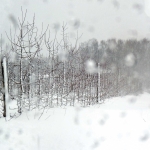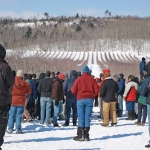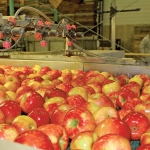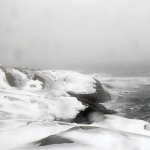There was an eerie sense of déjà vu as the nearly 300 growers and fruit industry professionals touring with International Fruit Tree Association braved the snowstorms and snow banks of Nova Scotia fruit growers’ orchards.
Hadn’t they seen this before?
Well, many of them had. But it was in summer, during August in 2009, when IFTA last visited the area.
The trees, most of them upcoming new varieties like Honeycrisp, SweeTango, Sonya, and Ambrosia, were smaller then, and growers have planted a lot more of them since. They still looked small now, the bottom three feet hidden under the snow.
The Nova Scotians were enduring in late February much the same record snowfall as their American counterparts across the Bay of Fundy in Massachusetts and Maine.
They were digging out after a five-day snowstorm that grower Peter Eisses described as the worst in ten years. On the plus side, temperatures were 30 degrees warmer than in the frigid Great Lakes region further west.
Just as if it were summer, six buses filled with growers from countries around the world made their way up driveways growers had carved through the deep snow. The snow wasn’t giving up, either. It was getting deeper.
About six new inches fell one afternoon during the tour. While everybody seemed to pretend it wasn’t happening, they clustered in a straw-bale storage barn at Waldo and Judy Walsh’s Birchleigh Farm and heard about—but never did see—the orchards.
The big change since 2009 has been the triumph of Nova Scotia’s image as a producer of the best Honeycrisp apples anywhere. During the five days of meetings—the first one devoted to a Honeycrisp Intensive Workshop—Honeycrisp apples were freely available, and they were big, red, crunchy, juicy, and still surprisingly flavorful in late February.
The Nova Scotians not only grow them well, but have learned how to store them in CA (controlled-atmosphere) and still pack out a high percentage of fruit free of bitter pit, internal breakdown, greasiness, rots, and other Honeycrisp problems.
At Stephen and Michael Van Meekeren’s storage and packing plant, the brothers were bringing apples out of storage that looked ready to package even before they were washed, waxed, and sorted. Van Meekeren Farms is the second largest apple packer in Nova Scotia, packing about a half million bushels a year. About half of the province’s two million bushels of apples are grown, packaged, and sold through the Scotian Gold Cooperative.
Tight industry
Nova Scotia’s industry is relatively small and compacted into the Annapolis Valley. It is very much organized around the co-op, Scotian Gold, and its fruit advisor, Larry Lutz.
As a result, the orchards are pretty uniform as most of the growers use the same rootstocks, plant the same varieties, use the same kind of trellising system, and talk to each other frequently.
Scotian Gold was formed in 1957. It has 55 members who produce all their fruit for storage, packing, and sale through the co-op. Another 20 growers contract with the co-op.
Weekly growers’ meetings are held from March to October, where they discuss orchard renewal, pest control, harvest management, fruit maturity, and, last year, the trauma-caused fire blight epidemic that followed 90-mile-per-hour winds of Hurricane Arthur, which hit Nova Scotia July 5.
In the shelter of the straw barn, Waldo Walsh talked about fire blight. Last year, he said, he adjusted his thinning program and decided to drop Apogee (prohexadione calcium), the growth regulator that is used to shorten and stiffen shoot growth.
“That was a mistake,” he said. There was a lot of tender tissue for the winds to damage, and, like many other growers, he will spend years pruning and spraying copper and antibiotics before his orchards recover.
Eisses Farms
In the two days spent on tours, the buses visited eight orchard operations, including one operated by John and Trudy Eisses, their sons, Peter and Dave, and son-in-law Ryan Swanson. Just the day before the visit, John had received IFTA’s Grower of the Year award.
John modestly admitted to having some of the deepest soils in the valley, which he said certainly helped him achieve what are said to be the highest per-acre apple yields in Nova Scotia, approaching 2,000 bushels per acre in some blocks. In Nova Scotia, thin, stony, gravelly soils are common.
Because of the weak soil, many orchards are planted on Malling 26 rootstocks, which are more vigorous than M.9 and Budagovsky 9. And many more orchards are free-standing, not needing trellis support.
Starting with a mixed farming operation including dairy and field crops, the Eisses family concentrated more and more on growing apples, expanding plantings and replanting to the point where the farm now has 125 acres of tree fruit.
The farm has 80 acres of high-density orchards planted to Honeycrisp, Ambrosia, SweeTango, Ginger Gold, Sonya, Gala, Golden Delicious, and Gravenstein. The Eisseses are among the province’s largest growers of Honeycrisp. They use several rootstocks, including M.26, M.9 and B.9, but are making more plantings on the Geneva rootstocks, G.11, G.15, G.30, and G.41.
The farm also has six acres of pears, including the new fire blight-resistant Harovin Sundown. Fire blight was widespread in their apples last year, Eisses said.
Spurr Brothers
Lisa Jenereaux, who has become a sparkplug in IFTA, a member of its board and a key organizer of the winter tour, showed off her new planting of pears (featured in Good Fruit Grower last September). The trees are bi-axis, with the two scaffolds aligned in the row and forming a tree wall rather than a “V” extending into the alleys.
Jenereaux is the fifth generation on Spurr Brothers farms, which is a diversified 800-acre enterprise that involves her father Bill, uncle Gordon, brother Will, and cousin Katie. The farm has potatoes, carrots, berries, onions, and grains. Jenereaux is the orchard manager.
While her ancestor William Spurr was among the first growers of McIntosh 150 years ago, Jenereaux grows Honeycrisp, Jonagold, Ambrosia, Gala, Sonya, SweeTango. Some older varieties persist, including Northern Spys.
Sarsfield Farms
Northern Spys have held on in Nova Scotia thanks to the Sarsfield family. Leonard Sarsfield started a pie company in the 1970s, building a reputation for great apple pie based on the Northern Spy apple. It did so well, the family quit growing apples. Leonard sold that company in 1991, but ten years later started another, called Apple Valley.
After selling the company, Blake Sarsfield, a cousin, wanted to return to the growing side. The farm he and his wife, Paulette, have now has more than 200 acres of apples, peaches, cherries, and strawberries. It is the largest producer of Honeycrisp apples in Nova Scotia, having started with the variety in 1996.
They use a variety of spacings and rootstocks, M.9, M.26, M.7, M.4, and Supporter 4. New plantings are made in rows 12 feet apart on M.9 roots.
And, true to its roots, the farm also grows Northern Spys.
Van Meekeren Farms
In addition to packing apples for themselves and their neighbors and selling them under the brand name Wink, the Van Meekerens import fruit from the Southern Hemisphere in the off season and pack and sell it as well.
The packing business has three members, in addition to brothers Steve and Mike, who are key employees.
They also grow 100 acres of apples. This next year they will be planting Honeycrisp and Gala to replace older varieties—and also to renew the farm after the devastating fire blight infection last year forced them to remove all their pear orchards.
Canard Orchards
Gerry and Shonna VanOostrum’s farm has been visited by IFTA several times in the past, and the orchards reflect the history of a progressive operation that evolved from free-standing, semi-dwarf trees to medium-density trees on single stakes to high-density trellised systems.
VanOostrum now plants everything on M.9 and B.9. The main varieties in the 90 acres include Gala, Honeycrisp, Ambrosia, Jonagold, SweeTango, McIntosh, and red strains of Cortland.
He also grows many of his own replacement trees and suffered some serious losses in the fire blight epidemic last summer.
The farm is named after their local town.
CAP Farms
Andy and Gail Parker own CAP Farms, which has about 100 acres of McIntosh and Honeycrisp, and many of the Honeycrisp are on old Empire and Northern Spy trees that were top-worked. The old spacing was 20-by-6 feet.
Recently, they have started a renewal program with an eye to mechanization in a tree-wall system on 11-foot rows with trees spaced two to four feet apart. Many of the new plantings will be budded in place with Pazazz, Honeycrisp, and other high-value varieties on M.26 rootstock.
Like many Nova Scotia growers, they were hurt last year by fire blight. They are now concerned whether they can prune and spray their way back or will need to replant. •










Leave A Comment